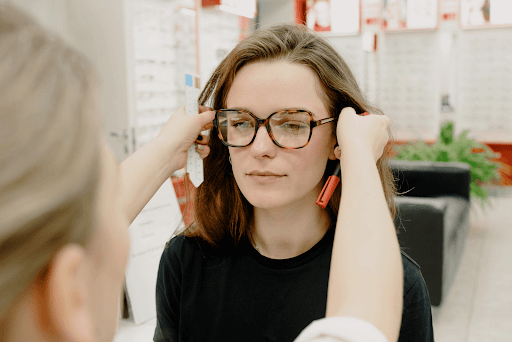Laser vision correction has undeniably transformed the way many view the world around them, offering a sharper and clearer perspective, especially for those grappling with refractive errors like astigmatism. In this blog, we will delve into astigmatism, its implications, and the nuances of recovery post-LASIK, ensuring you’re well-equipped with the knowledge to make informed decisions for your eye health.
Introduction to Astigmatism and Recovery Time
In the vast landscape of eye disorders, astigmatism stands out as a prevalent refractive error, affecting a significant portion of the global population. This vision problem, which can manifest as blurred vision, among other symptoms, demands thorough understanding and attention, especially when considering potential treatments and associated recovery time.
Understanding Astigmatism
At the very core, astigmatism is an eye condition where the cornea or lens doesn’t have the standard spherical shape. Instead, these parts might be more oval, leading to an uneven bending of light as it enters the eye. Ideally, in an eye without any refractive error, the cornea and lens work in tandem, focusing light directly onto the retina. However, with astigmatism, this isn’t the case. The uneven shape of the cornea or lens causes light to scatter, focusing on multiple points in front of or behind the retina, thereby producing distorted images.
Causes of Astigmatism:
Diving deeper into what causes this eye disorder, astigmatism can be innate, appearing from birth, or may develop over time. Often, it’s a hereditary trait passed down through generations. However, certain life events or conditions, such as eye surgeries, injuries, or disorders like keratoconus, can also be pivotal in its onset.
Symptoms of Astigmatism:
As for the symptoms, they are more than just blurred vision. Astigmatism symptoms can encompass a broad spectrum ranging from eye strain and headaches to challenges in discerning details both at a distance and up close. These vision problems can drastically impede day-to-day tasks, including reading or driving.
Statistical Prevalence:
Astigmatism is a prevalent eye condition. According to the American Academy of Ophthalmology, approximately one in three people in the United States has astigmatism to some degree. This highlights the importance of understanding the condition and exploring suitable treatment options.
Timeline of Astigmatism Recovery
LASIK surgery is a pivotal step in addressing vision challenges, and being informed about the post-operative period is crucial. After undergoing LASIK for astigmatism, patients might initially experience some visual haziness. However, the procedure’s effectiveness is evidenced by the significant improvement in optical clarity within just 24 hours, enabling patients to resume their daily activities.
The initial week post-surgery might present minor issues like dryness in the eyes. These are temporary and taper off as the days go by. The full healing phase can take up to one year, but about 80% of the healing takes place within the first month after LASIK.
Factors Affecting Recovery Time
Several elements can influence the LASIK recovery period. When considering the recovery duration after LASIK, it’s essential to understand the variables at play:
Severity of Astigmatism
The initial gravity of astigmatism can directly dictate the healing process. More profound cases might necessitate a slightly extended recovery time compared to milder instances.
Age
It’s a well-acknowledged fact in the medical realm that youth often correlates with faster healing times. Consequently, younger patients generally exhibit a speedier healing process after undergoing LASIK for astigmatism treatment.
Overall Eye Health
This perhaps is the linchpin. A patient’s eye health before the surgical procedure can greatly influence the recovery duration. Those with healthier eyes are primed for a more brisk and uncomplicated recovery phase.
Adherence to Postoperative Instructions
One’s recovery trajectory is greatly influenced by how meticulously they adhere to postoperative guidelines. Diligently following prescribed care routines and medications often results in optimal healing and lowers the risk of complications.
While LASIK provides an efficient route to correct astigmatism, several factors can influence the individual healing time and recovery duration. Being conscious of these can prepare patients for a smoother post-operative journey.
Comprehensive Treatment Options for Astigmatism
Astigmatism is a prevalent vision disorder that can significantly impact daily life. But with advancements in ophthalmology, an array of comprehensive treatment options are available. From surgical solutions to non-invasive aids, individuals with astigmatism are now equipped with various methods to improve their vision, ensuring they find the best fit for their unique needs.
Surgical Treatments and Their Recovery Times
In recent years, advancements in laser eye surgery have provided several effective surgical treatment options for those looking to correct vision problems. With numerous choices available, understanding the specifics of each can aid in making an informed decision.
LASIK (Laser-Assisted In Situ Keratomileusis):
Among the leading procedures, LASIK stands out for its efficiency and swiftness. Conducted by skilled eye surgeons, LASIK involves the creation of a thin flap on the cornea’s surface. Subsequently, a precision-focused laser reshapes the underlying tissue.
The corneal flap is then adeptly repositioned, ensuring a rapid healing process. The promise of LASIK lies in its post-op care with many patients reporting substantial vision improvement within a day or two.
PRK (Photorefractive Keratectomy):
PRK emerges as a distinct option within the spectrum of astigmatism treatments. Bypassing the creation of a corneal flap, PRK involves gently removing the cornea’s outermost layer, preparing it for laser reshaping. Consequently, PRK demands a more extended healing process. Although PRK can take up to one year for full and complete healing, most patients will see a strong improvement in their vision about one to three months post procedure.
LASIK remains a front-runner in refractive surgeries, bolstered by its quick turnaround and compelling results. When seeking expertise and unparalleled care in laser eye surgery, Saddleback Eye Center stands unmatched.
Our team of proficient eye doctors, state-of-the-art technology, and an unwavering commitment to post-op care ensure that patients receive the best possible outcomes. Choosing Saddleback Eye Center is not just about correcting vision; it’s about entrusting one’s sight to the best in the field.
Tips for Effective and Fast Recovery
For those undergoing eye procedures, a well-structured recovery plan is integral to achieving optimal results and ensuring long-term eye health. Incorporating patient care strategies that are both effective and tailored to individual needs is crucial.
Practical Recovery Strategies
At the heart of a smooth recovery lies adherence to recommended practices. Using eye drops, as prescribed by your physician, can not only alleviate discomfort but also play a pivotal role in preventing infections and promoting faster healing. Additionally, avoiding the urge to rub your eyes is essential, as this can disrupt the healing process. Wearing sunglasses, especially in bright environments, protects against potential irritants and harmful UV rays.
Post-Treatment Care
Beyond the immediate days following treatment, maintaining eye health is an ongoing commitment. Regular check-ups, adherence to recovery tips, and a consistent post-treatment advice regimen lay the foundation for lasting results and a swift return to daily activities.
If you’re struggling with astigmatism, it’s crucial to understand your options. Astigmatism is not just a minor inconvenience; it’s a common refractive error that can significantly blur your vision. While glasses or contact lenses might provide temporary relief, LASIK surgery offers a long-term solution. With its relatively quick recovery time, often within a week, and the promise of vastly improved vision, LASIK is a compelling choice for lasting clarity.
If you’re considering LASIK surgery, choosing a center with a strong reputation and proven results is paramount. Under the expert guidance of LASIK Specialist Dr. Manger, Saddleback Eye Center patients can expect nothing less than excellence. Utilizing state-of-the-art technology combined with years of expertise, our team is dedicated to providing top-notch care, ensuring you attain the clear vision you deserve. As temporary solutions fade, a more lasting clarity stands out as the superior choice. Contact Saddleback Eye Center today!
FAQ
Here we answer some of the most frequently asked questions on astigmatism recovery time.
What causes astigmatism?
Astigmatism can be congenital, present from birth, or may develop as one grows. It’s often hereditary, passed through families. External factors like eye surgeries, injuries, or conditions such as keratoconus can also contribute to its onset.
Is LASIK the only surgical option for astigmatism?
No, while LASIK is a prominent option, other surgical treatments like PRK exist. Each has its benefits and recovery times, making it essential to consult a specialist to determine the best fit for your condition.
Are glasses and contact lenses only temporary solutions for astigmatism?
Glasses and contact lenses effectively correct astigmatism and offer immediate vision improvement. However, they address the symptoms and not the root cause. LASIK and other surgeries aim to provide a more permanent solution by reshaping the eye’s anatomy.
What are the side effects post-LASIK surgery?
Common side effects post-LASIK include temporary visual disturbances like cloudiness or dry eyes. Most of these effects are transient and typically diminish within the first few weeks following the procedure. It’s essential to consult with your surgeon about potential side effects and any concerns you might have.
How can I ensure a swift and smooth recovery post-LASIK?
A structured recovery plan is crucial. Using prescribed eye drops, avoiding rubbing the eyes, wearing sunglasses in bright environments, and adhering to post-treatment advice from your surgeon are vital strategies. A healthy diet rich in vitamins, especially Vitamin A, can support faster healing and robust eye health. Regular check-ups post-surgery are also imperative.



